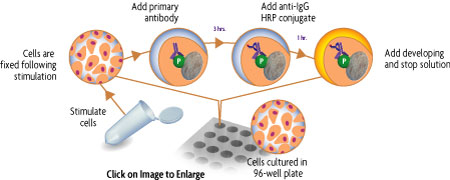THIS PRODUCT IS DISCONTINUED
Fast Activated Cell-based ELISA (FACE™) Kits provide a simple, sensitive method for detecting protein phosphorylation directly in the cell, without making extracts or performing electrophoresis and membrane blotting. These 96-well, high-throughput assays are available in both colorimetric and chemiluminescent formats for over 20 different targets (see list at right). For complete details, click the FACE™ Method tab below.
Each FACE EGFR Kit provides 96 rxns each of 2 antibodies that enable you to monitor and compare the levels of both phosphorylated and total EGFR. The Y845, Y992 and Y1173 kit each contain phospho-EGFR antibody that recognizes EGFR only when phosphorylated at Tyr845, Tyr992 or Tyr1173, respectively. Each kit also contains a total-EGFR antibody that recognizes EGFR regardless of its phosphorylation state. Click the EGFR Info tab below for data and more information.
| Name | Format | Cat No. | Price | |
|---|---|---|---|---|
| FACE™ EGFR (Y845) | 1 x 96 rxns | 48340 | Discontinued | |
| 5 x 96 rxns | 48840 | Discontinued | ||
| FACE™ EGFR (Y845) Chemi | 1 x 96 rxns | 48440 | Discontinued | |
| 5 x 96 rxns | 48940 | Discontinued | ||
| FACE™ EGFR (Y992) | 1 x 96 rxns | 48150 | Discontinued | |
| 5 x 96 rxns | 48650 | Discontinued | ||
| FACE™ EGFR (Y992) Chemi | 1 x 96 rxns | 48250 | Discontinued | |
| 5 x 96 rxns | 48750 | Discontinued | ||
| FACE™ EGFR (Y1173) | 1 x 96 rxns | 48190 | Discontinued | |
| 5 x 96 rxns | 48690 | Discontinued | ||
| FACE™ EGFR (Y1173) Chemi | 1 x 96 rxns | 48290 | Discontinued | |
| 5 x 96 rxns | 48790 | Discontinued | ||
| FACE™ EGFR Manual |
| FACE™ Profile |
| Cell Biology Products Brochure |
| IsoCyte™ Application Note – Phospho-Protein Detection |
| MSDS: Sodium Azide |
| MSDS: Sulphuric Acid |
| MSDS: Thimersol |

Figure 1: Detection of EGFR (Y992) phosphorylation using FACE.The FACE EGFR Kit was used to assay the level of phosphorylated EGFR (Y992) contained within EGF stimulated HeLa cells. FACE assays were performed before and 2, 10 and 30 minutes after EGF induction.
Antibody Specificities
The FACE phospho-EGFR (Tyr992), phospho-EGFR (Tyr1173) and phospho-EGFR (Tyr845) antibodies were raised in rabbits against synthetic phospho-peptides corresponding to residues surrounding phosphorylated Tyr992, Tyr1173 or Tyr845 of human EGF receptor. The phospho-EGFR (Tyr992), phospho-EGFR (Tyr1173) and phospho-EGFR (Tyr845) antibodies recognize EGFR only when phosphorylated at Tyr992, Tyr1173 and Tyr845 respectively. The total-EGFR antibody supplied in the FACE EGFR Kits recognizes EGFR protein regardless of its phosphorylation site.
EGFR Overview
Epidermal Growth Factor (EGF) Receptor (EGFR, HER-1, c-ErbB-1) is a member of the Epidermal Growth Factor Receptor family of Receptor Tyrosine Kinases. These cell surface receptors play an important role in the flow of information from the outside of a cell to the inside. Upon binding of EGF to the extracellular domain, the receptor undergoes dimerization and becomes phosphorylated on several tyrosine residues within the cytoplasmic domain. These result in EGFR activation and increased tyrosine kinase activity toward a variety of intracellular substrates. Autophosphorylation of tyrosine 845, 992 and 1173 are critical to EGFR signaling. Phosphorylation at tyrosine 992 creates a direct binding site for phospholipase C-γ (PLC-γ) resulting in activation of protein kinase C and subsequent downstream signaling cascades. Phosphorylation at 1173 creates a major binding site for the protein tyrosine phosphatase SHP-1, which can dephosphorylate EGFR and thereby block EGFR-induced activation of the ERK1/2 signaling pathway. Tyrosine 845 phosphorylation is mediated by integrin engagement and Src, and regulates receptor function and tumor progression.
The FACE™ Method
In FACE, cells are cultured in 96-well plates and stimulated to induce the pathway of interest. Following stimulation, the cells are fixed rapidly, which preserves activation-specific protein modifications. Each well is then incubated with a primary antibody specific for the activated protein of interest. Subsequent incubation with secondary HRP-conjugated antibody and developing solution provides a colorimetric or chemiluminescent readout that is quantitative and reproducible (Figure 1). The number of cells in each well can be normalized easily with the provided Crystal Violet solution. FACE Kits also contain primary antibody specific for the native inactive protein, so you can monitor both native and activated protein levels in the same experiment. FACE eliminates cellular extractions, radioactive kinase assays, time-consuming Westerns and inefficient epitope interactions that occur on membranes. FACE is a highly sensitive high-throughput assay designed for detecting activated proteins within mammalian cells.
Figure 1: Flow chart of the FACE process.
Flow chart of the FACE in cell Western method that uses a cell based ELISA to measure the levels of the native and phospho forms of signaling proteins and kinases that are activated by phosphorylation.
Contents & Storage
Two (or ten) 96-well plates for culturing cells, 96 (or 5 x 96) rxns each of two primary antibodies (1 phospho-specific, 1 specific for native protein), HRP-conjugated secondary antibody, Quenching Solution, 1X Antibody Blocking Buffer, 1X Antibody Dilution Buffer, 10X PBS, 10% Triton X-100, 1% SDS Solution, Developing and Stop Solutions, and Crystal Violet Cell Quantification Solution. Storage conditions vary from room temperature to -20°C, see manual for details. All reagents are guaranteed stable for 6 months when stored properly.


